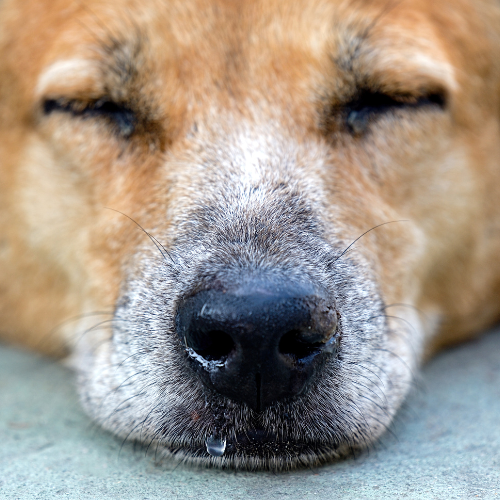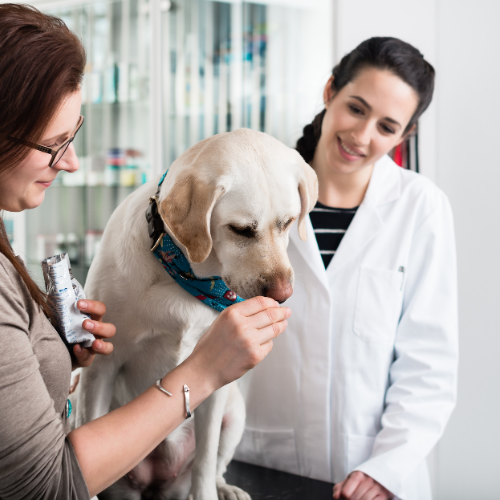Canine adenoviruses have two types: Type 1 (CAV-1), which is responsible for canine hepatitis, and Type 2 (CAV-2), which is responsible for infectious tracheobronchitis. Because the vaccine is readily available, the circulation of canine adenoviruses is low, though outbreaks are more frequent in countries that do not have systematic vaccination. Canine herpesvirus (CHV) often kills puppies and causes genital lesions and respiratory disease in adults.
It is recommended that you obtain a titer test prior to revaccination after 16 weeks of age. A positive result shows that your dog is immune to viruses or diseases. It is a good idea to voice your concerns about over-vaccination and the importance of titers to show immunity with your veterinarian. If your veterinarian does not listen or insists that vaccines are not harmful, you might consider consulting with another veterinarian.
According to the World Small Animal Veterinary Association (WSAVA), maternally derived antibodies (MDA) last only 8 to 12 weeks; thus, vaccinations are required in puppies. Some puppies may have weak MDA. Some vaccines may be administered as early as 3 weeks of age.
Understanding the Adenovirus Vaccine: Cause and History
CAV-1 causes ICH, which was once known as epizootic encephalitis of foxes and has been around since 1930. CAV-2 was first recovered from dogs that had laryngotracheitis in 1961. It was thought that it was a strain of CAV-1. However, it was later determined to be a distinct CAV and was named CAV-2.
Both types are of the Mastadenovirus family Adenoviridae. CAV-1 is vascular, while CAV-2 is respiratory and, to a limited extent, intestinal. In addition to dogs, wolves, red foxes and coyotes easily contract CAV infection.
Antibodies to the infection were found in island foxes from the Channel Islands in California and free-ranging marine mammals and terrestrial carnivores in Alaska and Canada, including fishers, black bears, polar bears, walruses, wolves and Stellar sea lions.
Vaccination for Canine Adenovirus Type 2
The vaccine that your dog receives is for Type 2, as it helps prevent Type 1, which is the cause of canine hepatitis. CAV-1 is uncommon, though sometimes veterinarians do see cases of canine hepatitis.
The vaccine for Type 2 is a "core" vaccine and is usually given in combination with other vaccines, including Bordetella and parainfluenza vaccines. According to the American Animal Hospital Association (AAHA), the CAV-2 vaccine can be given to puppies intranasally as young as three weeks of age.
It must be given nasally, as that is the only way maternally derived antibodies do not negate the efficacy of the adenovirus vaccine.
CAV-2 has more than one strain. Vaccination for adenovirus may not be against all strains of CAV-2.
Ingredients in the Adenovirus Vaccines for CAV-2
The Nobivac DHPPi vaccine of 1 ml contains:
- Live canine distemper virus (CDV), strain Onderstepoort ≥ 104.0 TCID50*
- Live canine adenovirus type 2 (CAV2), strain Manhattan LPV3 ≥ 104.0 TCID50*
- Live canine parvovirus (CPV), strain 154 ≥ 107.0 TCID50*
- Live canine parainfluenza virus (CPi), strain Cornell ≥ 105.5 TCID50*
Signs and Symptoms of CAV-2 Infection
CAV-2 is a transient infection of the respiratory tract that is quite common in dogs. It can cause:
- Mild fever
- Retching
- Sneezing
- Oculonasal discharge (watery discharge from the nose)
- Coughing (usually a dry, hacking cough)
- Pneumonia
- No appetite
- Lethargy
- Laryngeotracheitis
- Diarrhea (some cases may be fatal)
- Neurological disease
When in the presence of other pathogens, or if a dog has a compromised immune system, the adenovirus can cause severe necrotizing bronchitis and interstitial pneumonia.
Dogs that are in contact with other dogs have a higher risk of contracting CAV-2. Those who have been in breeding kennels, pet stores, shelters and rescue centers are more likely to contract CAV-2. If you board your dog at a kennel or doggie daycare, your pup is at a higher risk of developing the CAV-2 infection. Your dog could also pick it up at the groomers by engaging with other dogs every day and in dog parks.
Side Effects of Adenovirus Vaccinations
According to Today's Veterinary Practice, serious side effects are not common when using the modified live virus (MLV) CAV-2 vaccine, which also helps prevent CAV-1. While CAV-1 also protects against CAV-2, it has more serious side effects.
A National Center for Biotechnology Information study quoted by Today's Veterinary Practice showed that 36 percent of dogs that received the vaccine showed one or more of the following side effects:
- Lethargy
- Lymphadenopathy
- Gastroenteritis
- Local swelling and pain (one dog)
Less common side effects include hypersensitivity reactions and immune-mediated hemolytic anemia.
CAV-1 vaccines are no longer widely used, as they cause corneal edema ("blue eye") and interstitial nephritis. If your vet recommends vaccination for CAV-1, you should consider declining that vaccination.
Legal Requirements: Compliance and Documentation for Dog Owners
The American Animal Hospital Association considers the adenovirus vaccine a core vaccine, along with rabies, distemper and parvovirus. While not required by law, the adenovirus is prevalent enough to infect many dogs.
What is Big Pharma Not Telling You About the Canine Adenovirus Vaccines
According to Dr. Jean Dodds' corrected vaccine protocol, the adenovirus vaccine is "not preferred," as it can suppress the immune system for up to 10 days in puppies. It also increases the risk of developing post-vaccinal encephalitis (PVE).
However, if you wish to give the adenovirus vaccine, give it to older adolescents orally or intranasally with Bordatella, as it "induces interferon that protects against the upper respiratory viruses."
Warnings About the Adenovirus Vaccine
The adenovirus vaccine is often combined with distemper, parainfluenza virus, canine parvovirus and Leptospira vaccines. Leptospira vaccines are known to cause cancer in dogs. If you decide to have your dog vaccinated against CAV-2, ask your vet to administer the adenovirus vaccine without the Leptospira component of the vaccine.






Comments